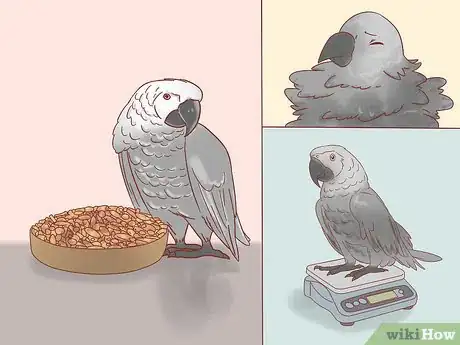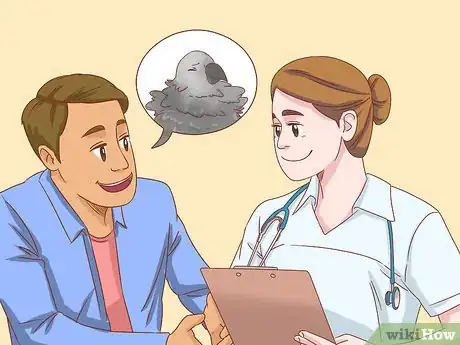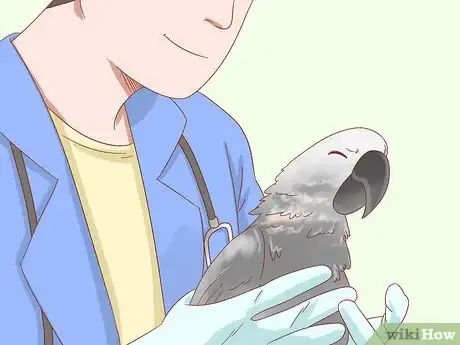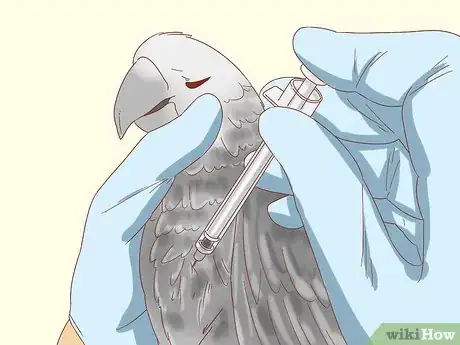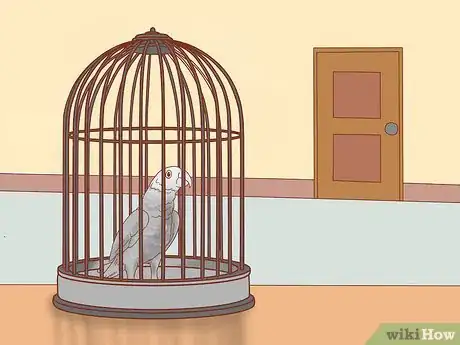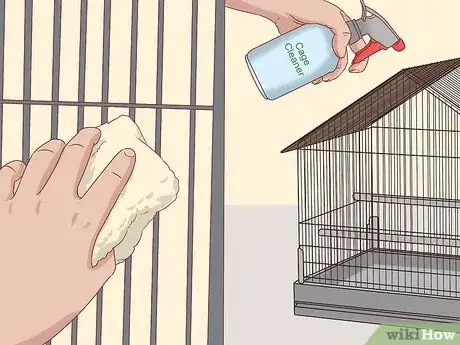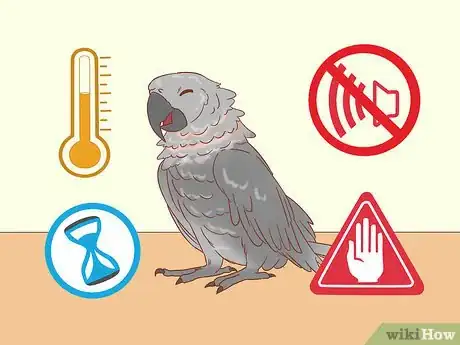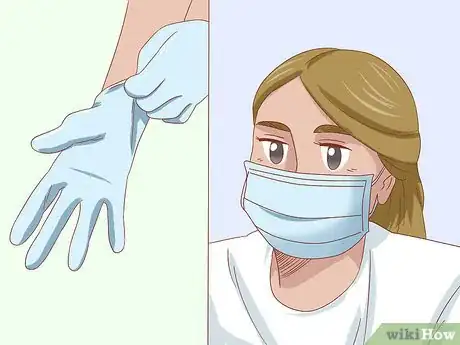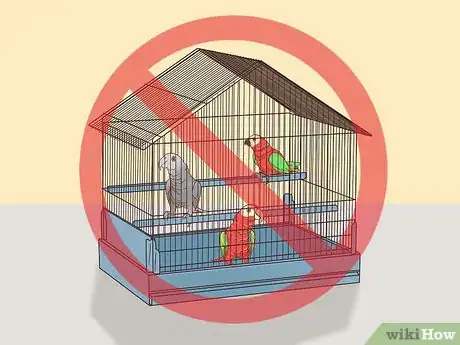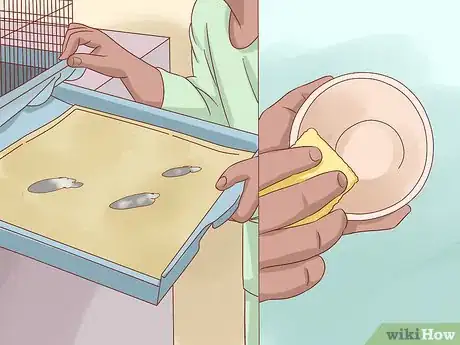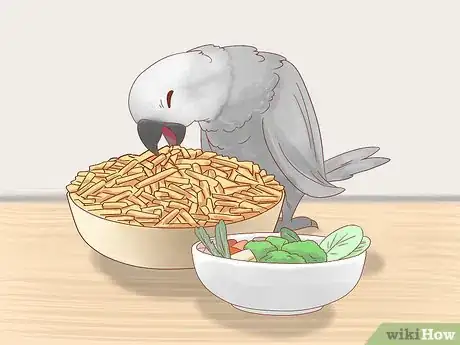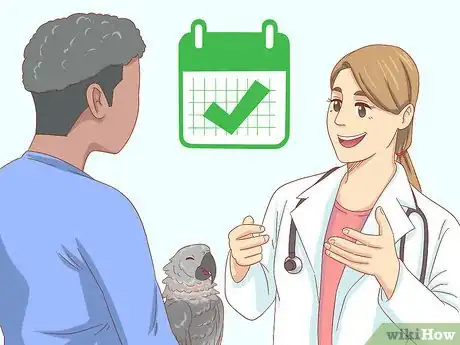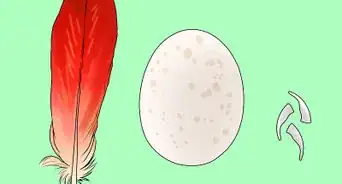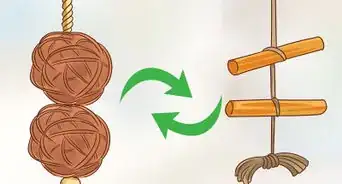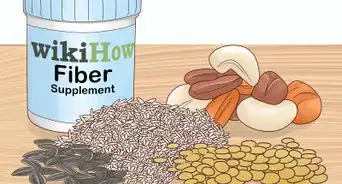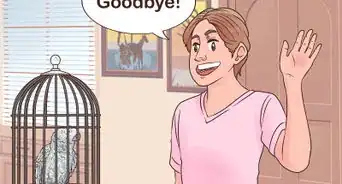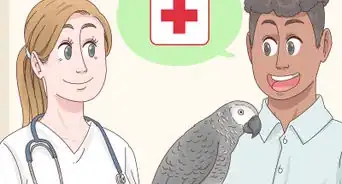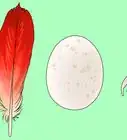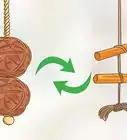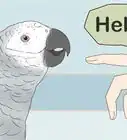This article was co-authored by Pippa Elliott, MRCVS. Dr. Elliott, BVMS, MRCVS is a veterinarian with over 30 years of experience in veterinary surgery and companion animal practice. She graduated from the University of Glasgow in 1987 with a degree in veterinary medicine and surgery. She has worked at the same animal clinic in her hometown for over 20 years.
This article has been viewed 12,352 times.
Psittacosis is a respiratory infection that can occur in African Grey parrots. This condition is best diagnosed and treated by a veterinarian, but by recognizing the signs and understanding the treatment process, you can help. It is also important to note that this condition can be spread to humans. If you believe your parrot has contracted Psittacosis, protect yourself with gloves and a mask.
Steps
Diagnosing Psittacosis
-
1Recognize symptoms to watch out for the illness. There are numerous potential symptoms of Psittacosis in parrots, and the way each bird exhibits the condition will vary. If you notice even one of these symptoms in your bird, it is best to consult your vet.[1] Psittacosis symptoms include:
- Loss of appetite
- Weight loss
- Ruffled feathers
- Green or yellow diarrhea
- Trouble breathing
- Nasal discharge
- Severe weakness
- Trembling
- Swelling around the eyes.
-
2Visit your vet for treatment options. If you have recognized symptoms of Psittacosis in your parrot, bring them to an avian vet immediately. Your vet will examine your parrot, and run a series of tests to help diagnose the condition. It is important to run a combination tests to get an accurate diagnosis.[2] Your vet will likely test:
- Any respiratory secretions (for antigen and/or antibody levels)
- Blood (for PCR levels)
- Fecal matter (to help diagnose secondary infections)
Advertisement -
3Diagnose any secondary infections. It is possible for your bird to become sick with Psittacosis as the result of a weakened immune system. If your vet suspects that may be the case, they may run additional tests. Your parrot may need additional treatment or medication to treat any secondary infections present.[3] Some common illnesses include:
- Aspergillosis
- Tapeworms, or other parasites
- Sarcocystosis
Treating Your Bird’s Illness
-
1Administer antibiotics by injection. The primary treatment for Psittacosis is a regimen of antibiotics. Often your vet will prescribe doxycycline, tetracycline, or a combination of these. Once your parrot has been diagnosed with Psittacosis, your vet will likely inject a strong dose of these medicines.[4]
-
2Continue antibiotic treatment at home. You will likely need to continue giving your parrot antibiotics after they return home. These antibiotics (usually doxycycline, tetracycline, or a mix) will come in liquid form. They can be added to your parrot's water.[5]
- Follow all dosage instructions from your vet.
- Continue to administer antibiotics for as long as your vet has advised. Do not stop early even if your parrot seems better. These courses of treatment usually last at least 45 days.[6]
- Depending on the type of antibiotic used, you may need to withhold calcium supplements, or calcium-rich foods from your parrot’s diet.[7]
-
3Quarantine sick birds. If you have more than one bird, the sick bird must be separated from the others. Ideally, you should move the sick bird to a separate residence, but if this is not possible, move the bird to a separate room and cover any vents. You may need to keep your bird quarantined for up to six weeks, or until your vet tells you it’s OK.[8]
- This should be practiced anytime you bring a new bird home as well.
- Use disposable gloves and a face mask whenever you handle sick birds.
- Wash your hands thoroughly after handling birds.
-
4Sterilize the cage with bird-safe cleaners. If your bird has been diagnosed with psittacosis, you must immediately sterilize their cage. Remove all liners, food and water bowls, and toys. Sterilize the inside of the cage, allowing the disinfectant to remain in contact with the cage for five minutes. Wash and sterilize all dishes and toys as well. Finally, replace toys/dishes and add fresh liners.[9] Bird-safe disinfectants include:
- Bleach solution made from ½ cup (118 ml) bleach to 1 gallon (3.8 L) (1.89 l) of water.
- 70% isopropyl alcohol.
-
5Provide general supportive care. If your bird has been diagnosed with psittacosis, they will need some time to heal. You can help your bird to recover more effectively by keeping them comfortable and stress-free.[10] You can do this by:
- Maintaining a consistent, warm temperature in your home. Between 65 °F (18 °C) and 75 °F (24 °C) is ideal.
- Providing adequate rest time for the bird.
- Limiting noise in your home.
- Limiting handling of the bird.
-
6Protect yourself from contracting Psittacosis. Psittacosis can be transmitted from birds to humans, and it can be a serious illness in people who have a weakened immune system. Most often psittacosis is contracted by way of human contact with infected pet birds. When handling a sick bird or cleaning the bird’s cage, wear a face mask and disposable gloves; always wash your hands after handling your bird (sick or healthy); and avoid beak-to-mouth contact.[11] Symptoms of psittacosis in humans are generally flu-like, and can include:
- Fever
- Chills
- Headache
- Dry cough
- People with weakened immune systems, including people who are young, old, or sick, should not handle sick birds.
Maintaining Your Bird’s Health
-
1Avoid over-crowding your birds. The minimum size cage for an African Grey is 20 inches (50.8 cm) long by 20 inches (50.8 cm) deep by 28 inches (71.12 cm) high. If you will be keeping two birds in the same cage, this size needs to double. Bigger cages are always better.[12]
- Overcrowding birds can lead to disease transmission.
-
2Keep your cage(s) clean. In order to keep your parrot healthy, you must provide a sanitary living environment, both when they are sick and when they are well. Every day, you must remove and replace all liners, and wash dishes with soap and water. Every week, you must remove everything from the parrot’s cage, and perform a deep cleaning. A clean cage prevents transmission of psittacosis.
- When your bird is sick, consider sterilizing the cage twice a week.
-
3Offer a healthy diet. Your parrot can better fight infection if they are equipped with a balanced diet. Specially formulated bird pellets should comprise about 70% of your parrot’s diet, with fresh produce making up the other 30%.
- Look for a pellet product formulated for parrots or cockatiels. Follow instructions for serving sizes.
- Some options for produce include: beet greens, carrots, peas, corn, broccoli, sweet potatoes, apples, apricots, and bananas. Provide your parrot with ¼ cup to ½ cup (59 to 119 ml) of fresh produce each day.
- Some foods can be toxic to parrots, such as avocado, chocolate, onion, and mango.
- Always remove any uneaten food after 24 hours.
-
4Provide routine veterinary care. Psittacosis (and other health conditions) can be most easily treated when caught early, sometimes before your bird shows symptoms. This can be accomplished by bringing your bird to see the vet every 6-12 months.[13] During routine veterinary exams, your vet will:
- Examine your parrot.
- Weigh your parrot.
- Perform blood tests.
- Perform a fecal exam.
Warnings
- If you experience flu-like symptoms, (such as fever, chills, or headache) and a dry cough, see your doctor right away.⧼thumbs_response⧽
References
- ↑ http://www.cfsph.iastate.edu/FastFacts/pdfs/psittacosis_F.pdf
- ↑ https://www.beautyofbirds.com/psittacosis.html
- ↑ http://www.cfsph.iastate.edu/FastFacts/pdfs/psittacosis_F.pdf
- ↑ https://www.beautyofbirds.com/psittacosis.html
- ↑ https://www.beautyofbirds.com/psittacosis.html
- ↑ https://www.brisbanebirdvet.com.au/wp-content/uploads/BBV_Psittacosis.pdf
- ↑ http://www.multiscope.com/hotspot/articles/psittacosis.htm
- ↑ https://www.cdc.gov/mmwr/preview/mmwrhtml/00053877.htm
- ↑ https://www.cdc.gov/mmwr/preview/mmwrhtml/00053877.htm
About This Article
If you spot any symptoms of Psittacosis in your African Grey parrot, like loss of appetite, weight loss, ruffled feathers, green or yellow diarrhea, trouble breathing, nasal discharge, trembling, or swelling around its eyes, consult your vet for diagnosis and treatment. Your vet may inject your parrot with a strong dose of antibiotics, usually doxycycline or tetracycline, and prescribe a course of liquid antibiotics to continue treatment at home. When you return home, you’ll usually need to add these antibiotics to your parrot’s water for at least 45 days to get rid of the infection. To help your parrot recover, maintain a consistently warm temperature of around 65 to 75 degrees Fahrenheit in your home and limit any noise. For more advice from our Veterinary co-author, including how to protect yourself from contracting Psittacosis, keep reading!
